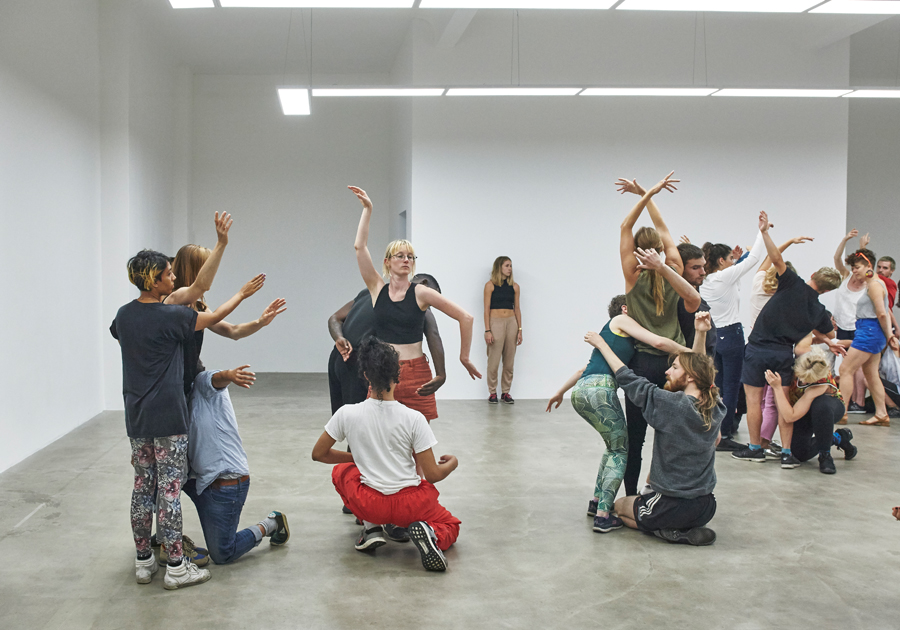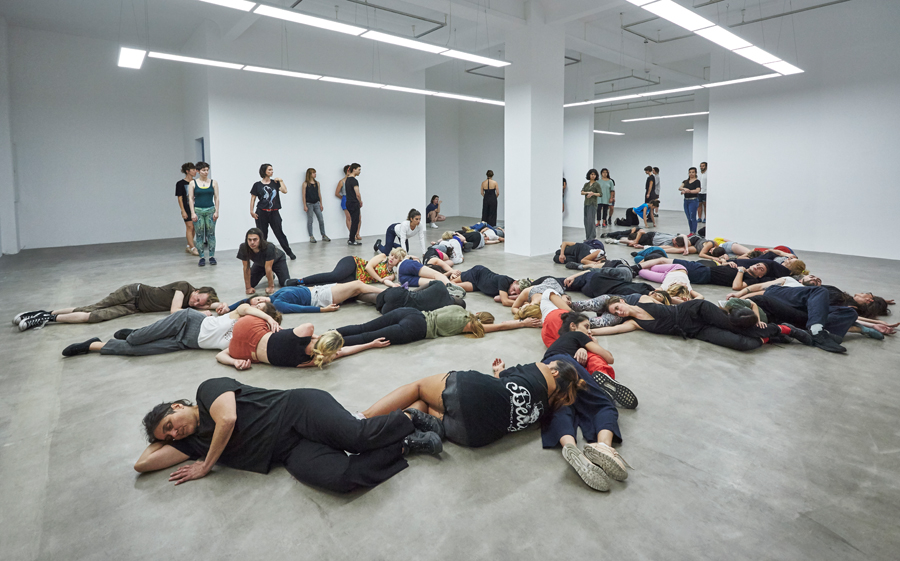Alexandra Pirici
Neuer Berliner Kunstverein, Germany
Neuer Berliner Kunstverein, Germany

Whenever I look at one of the performers directly, s/he responds with a Mona Lisa smile. The longer I smile back, the harder we both find it to control our expressions. Around half of the 80 performers who constitute the material for Alexandra Pirici’s ‘Aggregates’ are by no means trained actors. A quick glance at the company assembled within the twin spaces of Neuer Berliner Kunstverein, and this becomes apparent: here and there, tense shoulders, flickering eyelids, restless gazes, uneconomical gestures. Initially, I’m heartened by the fact that these representatives of art are so vulnerable in their roles.
Their smiling reminds me of Tino Sehgal’s ‘hmmm’. The performers who enact his ‘staged situations’ use this sound in place of an answer, both a comment on the responses they elicit from visitors and an aural link between the twists and turns of dialogue that unfold around them. Once identified, both Sehgal’s and Pirici’s codes appear as well-chosen mannerisms; with naturalness that slips to artifice, they both point to the aesthetic of a semipermeable fourth wall through which filtered communication between performers and visitors is possible.

In 2013, when Sehgal was awarded a Golden Lion at the Venice Biennale for his contribution to Massimiliano Gioni’s exhibition ‘The Encyclopedic Palace’, Pirici was showing work at the Romanian pavilion, creating live embodiments of key projects from the biennale’s history. Now, she too has begun to choreograph swarms. This alone reflects an interesting development in swarm aesthetics. From its beginnings as digitally triggered flash-mobs in public space, fed by both the energy of the Arab Spring and Occupy movements as well as studies in ornithology and fluid dynamics, it first conquered the stage and later the exhibition context, where it continues to synthesize shared space with the demarcations of the institution. As a semi-permeable fabric grouped around the audience, the swarm has come into its own: the principle of equality of professionals and non-professionals in postmodern dance as a post-material event.
Accordingly, the strongest experience in ‘Aggregates’ was the moment of entry, when I plunged into a crowd of 80 performers and roughly half as many visitors without being able to distinguish between the two. Before long, however, the postures of the performers, as well as the spatial principles and movement patterns inherent to the piece, become clear: loose rows intersecting at angles, groups of figures roughly mirroring each other’s movements, directional dynamics and counter-motion, facing towards and away, leading, again and again, to clusters, gatherings, throngs.
Within these principles, irregular sequences of predefined movements are repeated. They are drawn from a list, published online by Pirici, of 40 creatures and creations from natural and cultural history. Tigers, gorillas, eels; excerpts from Depeche Mode’s ‘Enjoy The Silence’ (1990) and Rihanna’s ‘Kiss It Better’ (2016); Michelangelo’s David (c.1504), Wifredo Lam’s Lisa Mona (1950), data noise, the Skype login sound, and so forth. The transitions between controlled referential gestures and formations of song and dance take place slowly. Due to the simple, monotonous sequences, the contemplative mood of the performers eventually becomes apathetic – and this apathy rubs off. When I take a break after one and a half hours (of the total four), my co-spectators from the start have largely departed; a few remain, semi-horizontal, as if waiting for the drugs to kick in.

The text accompanying the exhibition connects the repertoire of gestures and songs with an attempt to critically replicate the principle of a time capsule. Following this interpretation, the ‘Aggregates’ would reflect the ‘essential aspects of existence’ that are made ‘available for other, alien species’ (for example in NASA’s Voyager Golden Records). Presented with no emotional ties, the hieroglyphically simplified, random-seeming material barely goes beyond earworms and art-historical eye-candy. Canonization in cultural history, one might surmise, has to do with simplification. But how does such reductionist cultural Darwinism relate to the collective body?
‘Aggregates’ does not offer a direct answer. The principle of embodiment to which Pirici lays claim in interviews becomes sign language here – physicality in mimetic gesture. The replication of David looks as if the performers are adjusting their epaulettes; the Mona Lisa arm position, executed separately from the smile, feels like an awkward pose. The distinct bodies (labelled as individuals) seem to be gearing their impulses solely towards stereotypes. Admittedly, the entirety of human cultural history is a bottomless pit, and digitalization is unlikely to cure the segmentation of consciousness, but this simplifying homogenization hardly represents the birth of post-industrial mass psychology from a time capsule. More like the foundation of a score for post-ornamental event choreography.
One aggregation sees the performers congregate in a corner, reclining slowly into a single block of bodies, while chanting the chorus of ‘Enjoy the Silence’. Here, having acclimatised to the troupe’s intimate moments and movements in repetition, not being allowed to join in becomes frustrating. But as Pirici has warned: ‘Aggregates’ is not about imitation. Feel-good cultural criticism has its limits. Upon leaving n.b.k., I pass a Vietnamese restaurant playing the very same Depeche Mode song. I sing along. As an act of revenge. And, just a little bit, as an act of appreciation.
Translated by Nicholas Grindell
Main image: Alexandra Pirici, Aggregate, 2017, exhibition view, Neuer Berliner Kunstverein. Courtesy: Neuer Berliner Kunstverein; photograph: Joseph Devitt Tremblay
























